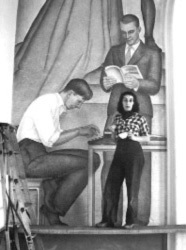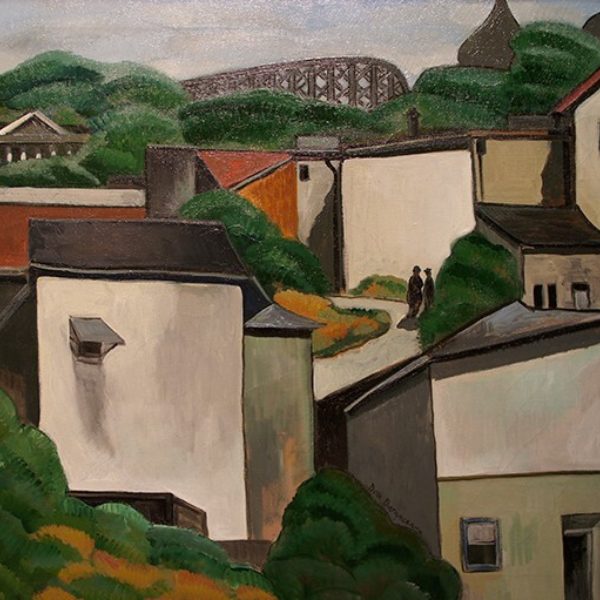
Belle Baranceanu
b. 1902, Chicago, IL - d. 1988, San Diego, CA
Although born in Chicago, Belle Baranceanu, the daughter of immigrant parents Mary Agnes Baranceanu and Abram Goldschlager, spent her childhood in North Dakota with her maternal grandparents after her parents’ separation when she was a young child. Her parents remarried and moved with Belle and her sister to Minnesota, where she graduated from the Minneapolis School of Art in 1924. It was there that she met Anthony Angarola, who was one of her teachers. She embarked on graduate study with Angarola in 1924/25 and moved with him to Chicago to continue studying at the School of the Art Institute (SAIC) in 1925/26. Her father disapproved of her growing intimacy with Angarola and sent her to live with her uncle in Los Angeles in 1927, but her personal and professional relationship with Angarola continued to flourish through correspondence and a visit from Angarola in 1927. In 1929, she returned to Chicago with the intention of marrying Angarola, who was scheduled to return from a Guggenheim fellowship in Europe in August. Angarola’s untimely death shortly after his return to Chicago probably changed the course of her life; although she stayed in Chicago until 1932, working with Todros Geller and teaching at a number of venues, in 1933 she joined her family in San Diego where they had relocated. She spent the rest of her life in California, painting murals for the Works Progress Administration (WPA) and teaching at the Francis Parker School in San Diego until 1969.
Her relationship with Angarola was crucial to the development of her style. He was a teacher and mentor who often made sketches in his letters to illustrate his critiques of her work. Her early work in particular shows evidence of her reliance on his advice and her familiarity with his painting. When her Riverview Section, Chicago (1926, San Diego Historical Society) was exhibited at the Art Institute’s 1926 Annual Exhibition of American Paintings and Sculpture, a reviewer commented that it could “at first glance be taken for an Angarola.” Even at this early stage of her career, however, Baranceanu has developed elements of a mature style. Her abstracted, flattened, and distorted shapes share much with Angarola and William Schwartz, as does the way in which she applies her paint in short visible brushstrokes. By this time, she had already developed a restrained palette and a complex way of layering space that created a perfect balance between abstraction and representation while pushing beyond Angarola’s typically more readable depiction of space. The Bobs, Riverview Park, is probably contemporaneous with Riverview Section, Chicago. She uses the same neighborhood as a subject and builds her composition in much the same way, creating a world of interlocking geometric shapes of endless variation and perfect balance. And although the Chicago landscape is completely flat, Baranceanu endows it with a feeling of rolling hills, making it similar as well to paintings such as Los Angeles Hills, made during her 1927–29 California period.
Susan Weininger
References
Dijkstra, Bram, and David Swanson. Belle Baranceanu: The Artist at Work. San Diego: San Diego Historical Society, 2006.
Dijkstra, Bram, and Ann Weaver. Belle Baranceanu: A Retrospective. La Jolla: University of California, San Diego, Mandeville Gallery, 1985.
Fisk, Karen. “The Annual American Exhibition at the Art Institute of Chicago.” American Magazine of Art 17 (December 12, 1926): 624.
Jacobson, J. Z. Art of Today: Chicago, 1933. Chicago: L. M. Stein, 1932. 42–43.
Weininger, Susan. “Belle (Goldschlager) Baranceanu.” In Elizabeth Kennedy, ed. Chicago Modern, 1893–1945: The Pursuit of the New, 87, 162. Chicago: Terra Foundation for the Arts, 2004.
Artist Image: Belle Baranceanu with her Seven Arts mural at La Jolla High School, painted for the W.P. A. in 1940 (demolished 1975) / unidentified photographer. The Journal of San Diego History.
